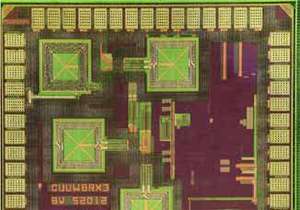Engineer designs self-powered nanoscale devices that never need new batteries

(Phys.org)—It's relatively simple to build a device capable of detecting wireless signals if you don't mind making one that consumes lots of power. It's not so easy to design energy-efficient devices that function as well as the components they replace, or to do it at the nano scale.
That's what Peter Kinget, a professor of electrical engineering, works on. He and his colleagues at the Engineering School are attempting to build self-powered systems using nanoscale devices that can transmit and receive wireless signals using so little power that their batteries never need replacing.
Rather, they rely on tiny bits of ambient solar energy to recharge themselves. Such energy efficiencies could dramatically cut down on the cost to operate a variety of these devices at once, while eliminating the need for maintenance. These sensors would only need to be installed once, and could remain in place functioning autonomously—practically until they wear out or disintegrate on their own.
Kinget's work is made possible by recent advances in nanotechnology—in general, he explains, the smaller the components of the tiny devices, the less energy is required to allow them to operate.
"We are using and exploiting the fact that power consumption—and the energy you need to do things—becomes very, very low as you pack more and more functionality into smaller and smaller spaces," he says.
"The bad news," he adds, "is that as the transistors become smaller, there are also clear disadvantages—nanoscale transistors are not as reliable, they cannot sustain large signal levels. The only way to deal with them is to come up with new design concepts."
Kinget's chips—some of them 100 times more energy efficient than most standard technologies—could be deployed for many different uses in future. Embedded in clothing, they could transmit the location of victims during disasters. They could be affixed to the walls of apartments across New York City and monitor heating or energy consumption patterns, which could then be analyzed to manage the heating systems or the power grid better. They could even collect and transmit data about humidity and temperature to computers designed to recognize and predict weather patterns.
While the tiny size of the components allows them to operate on far less energy, they are so fragile that they can tolerate only low voltages.
One solution is to create a device that is less accurate at detecting individual signals but far better at detecting more of them in parallel or more of them per second—"oversampling" the signals and then averaging them out.
To save power, Kinget's chips also are designed to network. Instead of passing wireless signals from their origin to destination in one giant leap, the chips use a relay system, passing signaling information from one chip to the next, like a line of citizens in a flood zone "bucket brigade" passing sandbags down a human chain to a river bank. This network relay system means that each chip only has to transmit short distances, consuming less power than large chips transmitting over a far longer range.
The chips also have a learning phase when they go online, in which they detect the intervals at which the chips in their vicinity are transmitting data and then "self-synchronize." This allows them to remain idle—consuming no power—when they are unlikely to receive transmissions from neighboring chips and switch on when they are.
"It's much simpler to build something that listens all the time," Kinget says. "But nanotechnology allows us to integrate much more sophisticated systems in tiny chips, so we can save energy."
Kinget grew up and studied in Belgium. After completing his electrical engineering Ph.D. in 1996, he worked at the famed Bell Laboratories in Murray Hill, N.J. He joined the faculty of Columbia's Department of Electrical Engineering in 2002.
Kinget and his team don't fabricate chips themselves. After designing their chips, they send their specifications to industrial factories known as silicon foundries, and then install the factory-made chips in their systems when they arrive.
Provided by Columbia University




















